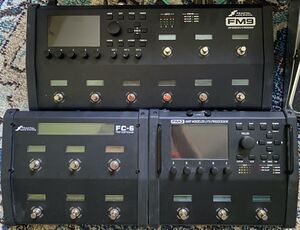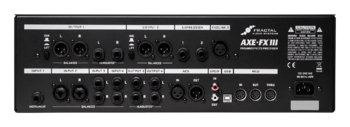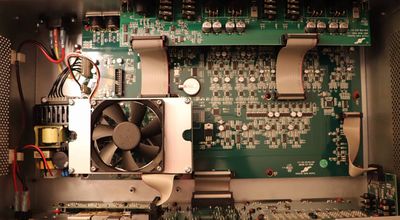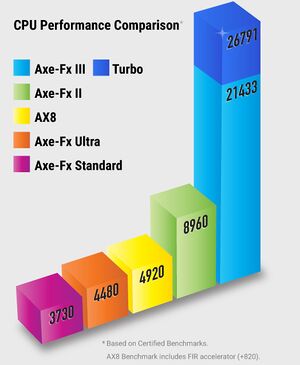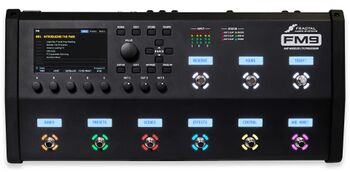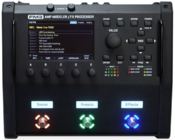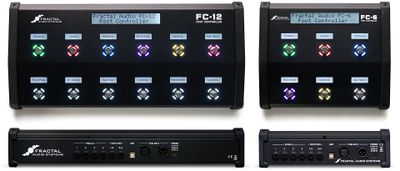Always consult the official Owners Manuals first
Axe-Fx III, FM9 and FM3
Contents
References
![]()
All devices: Website — Owners Manuals
Axe-Fx III: Product page — Downloads — User forum — Wiki pages
FM9: Product page — Downloads — User forum — Wiki pages — FAQ
FM3: Product page — Downloads — User forum — Wiki pages — FAQ
Rig pictures
Owners show their rigs:
Product family
Fractal Audio has published a Product Comparison Table.
Visit this page for a comparison with the Axe-Fx II: Comparing the Axe-Fx III to the Axe-Fx II.
"The entire product line was conceived years ago. The goal was to maximize the number of parts shared between products. The footswitch PC boards do three switches each. An FM3 has one board. An FC6 has two. An FM9 has three and an FC12 has four. All products use the same LCDs, encoders, side plates, etc., etc. This reduces cost and repair inventory. The FC6 and the FM3 are basically the same enclosure. The FC12 and FM9 are basically the same enclosure. This isn't a huge market. Margins are thin so you have to think of ways to minimize development and product costs. Parts bin methodology is the route we took on this generation." [1]
"It's a new platform. It will grow over time. It was time for an updated platform. TigerSHARCs are discontinued, the interface was dated, etc. The III is what the II would be if we could've upgraded the hardware via a firmware update." [2]
"Remember it's a lot of work migrating stuff to a new architecture. The III is a brand-new platform. Just as the II had dozens of firmware update the III will receive many updates and there's so much power there that we can improve everything over time." [3]
"Large screen meant we had to make it 3U. But it's much shallower than the II." [4]
(Axe-Fx III) "Internally, the unit features a DSP module that is made in the USA and mechanical design guided by years of experience designing dependable rackmount units for touring musicians."
"The FM9 uses (2) dual-core SHARCs. The FM3 has one. The code for the various blocks is, for all intents and purposes, identical. Updates for the FM3 and FM9 should be pretty much in lockstep." [5]
"FM9 uses the same processors, compiler and development environment as the FM3."
"The III uses (1) dual-core Texas Instruments DSP. The FM3 uses (1) dual-core Analog Devices DSP. The FM9 uses (2) dual-core Analog Devices DSPs. The TI DSPs are much more powerful than the Analog Devices DSPs per clock and run at around twice the clock speed as well. So one TI DSP core is about four times more powerful than one Analog Devices DSP core. If we normalize processing power to the III it would be:
- Axe-Fx III: 100%
- FM9: 50%
- FM3: 25%
So why not use the TI DSPs in everything? Power. The TI DSPs use more power and generate more heat requiring active cooling. They are also more complicated to use requiring dedicated clock generation units, multiple power supplies with specific sequencing requirements, etc." [6]
(FM9) "It has twice the DSP cores of an FM3. Four SHARC+ DSP cores. So it has about twice the processing power. [7]
"FM3 and FM9 use the same SHARC+ family as the QC. FM9 has same number of cores so power should be comparable." [8]
"The processing power of an FM-3 is roughly the same as an AX-8."
"It's not nearly as powerful as an Axe-Fx III but it's a cool little unit."
"The FM3 is not as powerful as an Axe-Fx III. The Axe-Fx III has at least four times the processing power."
"Uses an SC587. The SHARC+ core has essentially the same MFLOPs as the SHARC. The overall processing power is greater than an AX-8 because of the ARM which offloads all the housekeeping stuff, USB, etc."
”The FM3's CPU utilization meters are normalized so that 100% represents the amount of the CPU that can be allocated to audio processing. So you can go right up to 100%. However, if you ever cross 100% things will get shut off without your consent so you still need to be careful.”
(comparing the amp modeling to the Axe-Fx III) "They are the same quality. Certain features were removed to allow the algorithms to run including the bias tremolo, input dynamics processing, and several other inauthentic enhancements." [9]
"We removed all the superfluous stuff (bias tremolo, dynamic presence/depth, etc.) in order to get the core amp modeling to run on the slower processor." [10]
"The Axe-Fx III contains various algorithms that allow you to enhance the amp modeling that don't exist on a real amp. I.e. dynamic presence/depth, input dynamic processing, etc. These were removed to allow the core amp modeling to run on the lower-powered processor." [11]
(Cab block runs on CPU accelerator) "It's a CPU accelerator thing. A second Cab block would use a lot more than 3%."
"FM3 CPU is normalized so it's tricky to get an apples to apples meter comparison with A3 for that reason among others."
"FM3 has an additional core to handle UI/Midi/Footcontoller stuff so that freed up some CPU. Additionally a bunch of little optimizations you find while working in the code for a long time. 1% here, 1% there adds up."
"(...) The DSP power makes it the second most powerful amp modeling product on the market behind only the Axe-Fx III. Adding another DSP would increase the price substantially. The increase would be more than the price of just the DSP since larger power supplies would be required, etc. This would price the unit above our target price." [12]
"The FM3 DSP is three cores and also supports floating-point, has dual DDR3 memory busses, hardware FFT and FIR accelerators, etc."
"The Delay block shares a core with amp modeling on the FM3." [13]
(FM3) "The CPU % displayed is the primary CPU %." [14]
"The FM3 is somewhere between the AX8 and the II. Probably closer to the AX8. The new SHARC+ DSPs aren't terribly fast. In fact they're a tiny bit slower than the previous generation SHARCs. However you get two DSP cores plus an ARM core in a single package that only consumes a couple watts. They also have dedicated FFT and FIR accelerators whereas the previous generation you could only use either-or. The pipeline in the SHARC+ is a lot longer and there's an extra cycle of instruction latency for many operations which slows things down if you don't code around it. We had to rewrite all our assembly libraries to compensate for this. Pain in the rear. The memory bus is a little faster though and there's better caching which improves overall performance. Still, the SHARCs pale in comparison to the Keystone DSP in the Axe-Fx III. That thing is a monster. But it also costs three times as much and needs a lot of ancillary support ICs. The net DSP cost is probably around 7-8 times higher." [15]
"Under certain circumstances (using an Amp block and two Delay blocks with Diffusion on) the second DSP could get overloaded. The easiest solution at this time was to remove the Diffusion parameter. If we are able to improve the code efficiency we will reinstate the parameter. You have to realize the FM3 has only about 1/5 the DSP power of an Axe-Fx III. Trying to fit all those goodies in there while not sacrificing audio quality is a balancing act. I ALWAYS insist on quality over quantity. That's what differentiates our products. It takes a LOT of horsepower to do it right." [16]
(FM3) "The Cabinet block uses an FIR accelerator to do the IR processing. This FIR accelerator offloads processing from the CPU and, as such, doesn't reflect in CPU usage." [17]
"The value proposition of the FM3 is unmatched. It encompasses the entire history of Fractal Audio and all our algorithms and technology developments of the last 15 years." [18]
"The FM3 is not really geared towards amp integration. It's primarily intended to be a standalone solution with a single fx loop. For amp integration or multiple loops we recommend the FM9 and Axe-Fx III." [19]
"The converters in the FM3 are the same high quality as those in the Axe-Fx III." [20]
”FM3/9 only support 1K samples for normal IRs since the IR processing is handled by a coprocessor whose max. length is 1K samples.” [21]
Specifications
Axe-Fx III
- Width: 19.00" (482.60 mm).
- Height: 5.16" (131.10 mm). That's 3U.
- Depth: 11.530" (292.87 mm) including front handles and rear jacks. From the faceplate to the rear jacks: just under 10" from the mounting face of the faceplate to the edge of the jacks. [22]
- Weight: 15 lbs 2.4 oz (6.87 kg).
Processors
- Two 1.0 GHz floating-point “Keystone” DSPs (TMS320C66x) (2.8 times faster than the TigerSHARC DSPs in the Axe-Fx II). The Turbo module has a 1.25 GHz processor.
- Video display processor.
- 500 MHz 16-core XMOS USB microcontroller:
- Supports 8x8 audio at 48kHz, 24-bits
- MIDI-Over-USB is about 10x faster than an Axe-Fx II.
Memory
- PC1600 DDR3 memory.
- Hundreds of MB of FLASH memory.
- Enough non-volatile memory for over 4000 IRs.
Screen
- Custom-design full-color 800x480 TFT display. Specifically designed to provide animation. The backlight intensity is not adjustable.
- Mark II model:
- "New IPS Display offers improved contrast, better viewing angles and more vivid colors"
- "Adjustable RGB LEDs let you set the color and brightness of the front panel logo".
(Mark I) "You can turn it down but you can't turn it off. There is no danger of burn-in as it's an LCD not an OLED." [23]
(Mark I) "The LCD is designed for viewing angle and sunlight readability. It's not designed to watch movies in dark conditions." [24]
The third "I" in the logo may appear less bright than the other characters when viewed from an angle. Nothing to worry about. Use the Utilities menu to set the brightness and color of the logo on the Mark II model.
Analog I/O
- Audiophile-quality components.
- Auto Input Impedance.
Grid
- 12x6.
Backup battery
- CR-2032.
"You can install the battery yourself. It's a standard CR2032 motherboard battery." [25]
"The Axe-Fx III uses a battery for system data backup. Whenever the user changes any global data that data is flushed to battery-backed storage. We use battery-backed SRAM instead of EEPROM or FLASH because it's very fast and unlimited endurance. EEPROM is very slow and there's a risk that the user turns the power off before the flush is finished. FLASH has limited endurance (as well as being slower the SRAM) and there's a risk of wear-out. The battery should last 10 years under normal conditions and is user replaceable." [26]
Output:
- 20 dBu maximum.
Power and temperature
The Axe-Fx III has a universal power supply. Power consumption is less than 40 watts.
When powering on, the III displays diagnostic messages during the first phase of the boot routine.
(about fan noise) "Actually the problem was the lock nuts were too tight. The fan is mounted on rubber bushings but the nuts were too tight compressing the bushings." [27]
"It turns on when the internal temperature is above a pre-set threshold." [28]
There's no harm in leaving the processor turned on all the time. [29]
There is power transient suppression circuitry, so that the Axe-Fx III won't make any loud pops when powering on/off.
(about heat) "Less than an Axe-Fx II." [30]
"The DSP won't get damaged if it overheats, it will just stop working. I've yet to see a unit overheat. Our products are overdesigned." [31]
"There is a voltage monitor that reboots in the event the voltage drops below a certain threshold." [32]
"The III has power on/off detection circuitry that mutes the outputs when it detects a power transient." [33]
"The power supply is an off-the-shelf Cincon 40W, triple-output supply. Cincon is a good manufacturer and makes an excellent product. They've been around for a long time. They are carried by Mouser and DigiKey. Those distributors do not sell inferior products." [34]
"The power switch has some glue around it to prevent it from sliding around in the opening. It's an additional step that's unnecessary but improves the perceived quality of the product." [35]
"Going all the way back to the original Axe-Fx I used a concept called a "Mailbox" to communicate between processors. Each processor has an inbox and an outbox. I'm self-taught in programming and computer science so it was just a way I came up with to send data back and forth. Turns out that mailboxes are actually a technique used in interprocessor communications. In this specific case the processor is checking the mailbox from the front panel to see if any buttons were pressed at power-on." [36]
"To reduce boot time some of the boot tasks (copying presets and cabs from slow FLASH memory to fast DDR memory) are done in the background. This takes a couple minutes to complete and reduces CPU power available to servicing other low-priority tasks. Once the tasks are completed any lag will go away." [37]
Fractal Audio:
(comparing to the Axe-Fx II XL+) "It actually does sound a little better. The extra DSP horsepower means that we didn't have to make compromises in some of the algorithms. The amp modeling algorithm is very similar but there's a few places on the II where we had to make compromises to get the algorithm to run within the allotted time. Also the III has a higher internal oversampling rate and a higher bit depth on some calculations (64-bit vs. 40-bit)." [38]
"The Axe-Fx III was designed so that single preset can be thought of as an entire rack full of processors. Each virtual processor has up to four presets. So if you were trying to do spillover in a rack you would use two reverb processors." [39]
"These Keystone processors chew through data like a hot chainsaw through a sorority girl. The Axe-Fx III is a beast. I don't think people realize how powerful it is. It has the equivalent power of 8 SHARC chips, at least. And that's just the DSP. The memory bus is 3-4 times faster than other stuff." [40]
"The only product more transparent than the FX-8 is the Axe-Fx III." [41]
"The Axe-Fx III, FM3 and the other products in development all use the "Ares" architecture. This is a portable client-server architecture that allows easy porting of effects and models between hardware platforms. When we ported the Axe-Fx III models to the FM3 it involved nothing more than copying the file. We created the Ares architecture three years ago and all new products use it. It's a comprehensive hardware and software paradigm that allows any number of clients to communicate with a DSP server. The architecture supports multiple DSP cores. Clients can be located on the same core, a different core on the same IC, a different IC on the same board or on completely different hardware, i.e. an editor running on a PC or a foot controller. For example on the FM3 the UI is a client running on the ARM core. The Ares architecture is even processor agnostic. The Axe-Fx III uses TI DSPs while the FM3 uses Analog Devices. The Ares architecture was a huge undertaking with the ultimate goal of faster product development and easy synchronization of multiple product lines. It allows me to work on algorithms and new models and the engineers can then easily port those to the other products." [42]
"TI makes the most powerful DSPs, by far. The only DSPs more powerful than the one in the Axe-Fx III are the family members with more cores, but they're too expensive for a consumer product." [43]
"It was a monumental amount of work. The DSP board design was the most difficult hardware design we've ever done. It's a 10-layer board with all fine-pitch technology. Then migrating all the algorithms to a new processor architecture. The team did a phenomenal job." [44]
"The digital signal is 32 bits." [45]
"The Axe-Fx III uses 32-bit floating point." [46]
"32 bit floating point mostly. 64 bit floating point in critical locations in the amp block." [47]
"64-bit processing is used in critical locations to minimize coefficient sensitivity." [48]
"The chassis and some of the boards are made in China. The DSP module is made in Merrimack NH, USA." [49]
"Roughly 50% (by cost) of the Axe-Fx III is made in USA. The chassis and simpler circuit boards are made in China. The DSP module is made right here in NH. [50]
"The Axe-Fx III is about 50% domestic content. [51]
"The front panel around the buttons is steel and covered with a polycarbonate overlay. The bezel is anodized aluminum." [52]
"Designing a product is all about compromises. Do you want a phantom power mic input? Well that costs money. So either you have to raise the price of the product or cut costs somewhere else. For something that only a small percentage of people will use. Since we target the pro market our customers will likely use their own mic pre's like a Neve or API. So we don't include it and don't have to cut costs on other things." [53]
"The Axe-Fx III is assembled, programmed, inspected, and tested at our facility in New Hampshire." [54]
"FWIW the backlight in the Axe-Fx III is not PWM. I had the OEM change it to a circuit I designed. I eliminated PWM sources inside the unit wherever possible so as to keep EMI to a minimum." [55]
"In general I overdesign things. I.e. if a capacitor is used to filter a 5V rail most designers will spec a 6.3V part. I'll spec a 10V part. For electrolytic caps I always spec long-life and high-temperature parts. We always use ENIG (electroless nickel immersion gold) circuit boards with FR-4 cores, no phenolic crap or HASL." [56]
"The glue is just to keep the switch from sliding around in the opening. It's a snap-in type like many products use now. You may have noticed those types tend to slide around a bit in the opening. So we put a little glue on there to make it more secure. It's unnecessary and an extra manufacturing step but makes the switch feel better. The Axe-Fx III does not make any compromises. Every part used is high quality. The converters are Cirrus' highest performance models. The capacitors are high-temperature, low-impedance, long-life parts (Panasonic FK series, look 'em up). The power supply costs closer to $27. The DSP module alone costs close to $250. The analog paths use premium op-amps, not the cheap TL07x and NE553x used in most other products." [57]
"Over 50% of the Axe-Fx III is made in the USA." [58]
"We use Panasonic FK series which are high-temperature, long-life series. For many applications aluminum electrolytic capacitors are the capacitor-of-choice. For power supply filtering they are unequaled in voltage-capacitance product for a given volume. Yes, MLCCs now offer competing capacitance per volume but don't offer the voltage rating. Also MLCCs are more expensive. You don't simply use something more expensive if that doesn't offer any tangible benefit. For audio coupling applications it's hard to beat aluminum caps. MLCCs have a far worse voltage coefficient for those high-capacitance dielectrics." [59]
"The LEDs are just debug LEDs for development use. They don't mean anything to the end user."
Read this post about the parts and manufacturing
More pictures of the circuit board
Axe-Fx III Mark II
Announced in September 2020, replacing the first model.
- New IPS Display offers improved contrast, better viewing angles and more vivid colors.
- Double the preset memory = space for 1024 presets.
- Adjustable RGB LEDs let you set the color and brightness of the front panel logo. The controls are located in the Utilities menu.
- Increased FLASH memory for future expansion.
"It's not extra firmware space. There's already plenty of that. It's extra FLASH for "future expansion". This might be factory or user cabs or some other data. I have several ideas I'm kicking around that would use it." [60]
"The same firmware runs on both." [61]
"The firmware ROM is the same size and many times larger than what we are using." [62]
"The ID is the same." [63]
Firmware 17 added a user bank for FullRes IRs to the the Mark II and Turbo.
Presets between the original and the Mark II are completely compatible.
Axe-Fx III Mark II TURBO
Made available from September 2021. A TURBO module is available as an option when buying a new Mark II. This provides a 25% higher clock speed allowing for more complex presets which would exceed the limits of the standard DSP module. Existing Mark II units can NOT be retrofitted with the module.
"Everything is the same except the processor speed. The Turbo module has a 1.25 GHz processor. The standard module has a 1.00 GHz processor. Some of the supporting components (power supply stuff) are also different but that's not visible to the user." [64]
"Same fan." [65]
"It's a new processor. We do not and would not overclock anything. No OEM would ever do such a thing." [66]
FM9
- Dimensions: 20.2″ x 9.2″ x 3.5″ (512mm x 233mm x 88mm). The FM9 is the same size as the FC-12 controller.
- Weight: 11 lbs 15.8 oz (5.44 kg).
- Two dual-core SHARC+ DSPs (original: 2x 450Mhz, Turbo: 2x 500Mhz).
- Screen: 800×480 high contrast color LCD (same on the Axe-Fx III Mark II). Grid: 14x6 (same as the Axe-FX III).
- Power Consumption: <40 W.
- Fan: side and bottom venting, thermostat-controlled. WARNING: Do not block vent holes!
- Headphones output: 35 Ohm.
- Pedal ports: 3, TRS (pedal or single switch), 10–100 kΩ max (pedal).
- A/D and D/A: 24-bit, 48 kHz, 114 dB dynamic range, frequency response: 20 – 20kHz.
- Instrument input: rear 1/4" phone jack, unbalanced, “Secret Sauce IV”, 1 megaohm (variable), max. input level: +16 dBu.
- Analog input 2: L/R, 1/4" phone jack balanced (TRS), 1 megaohm, max. input level: +20 dBu.
- Analog input 3: L/R, 1/4" phone jack balanced (TRS), 1 megaohm, max. input level: +20 dBu.
- Analog output 1: L/R, XLR balanced, ground lift, -10 dBv or +4 dBu, 600 Ohm, +20 dBu max.
- Analog output 2: L/R, XLR balanced, ground lift, -10 dBv or +4 dBu, 600 Ohm, +20 dBu max.
- Analog output 3: L/R, 1/4" phone jack unbalanced, Humbuster, 600 Ohm, +20 dBu max.
- USB: Type B port, USB 2.0, 8x8 USB Audio (48 kHz fixed).
- Auto Input Impedance.
- FASLINK II: XLR-F.
- MIDI: IN (5-pin DIN) and OUT/THRU (5-pin DIN).
- S/PDIF: RCA Coaxial, uncompressed PCM, 48 kHz (fixed).
- Battery: CR-2032.
- Grid: 12x6.
- IRs: 1K max.
The internal and ambient temperatures are displayed in the Utilities menu.
Amp modeling, Delay blocks and Reverb blocks run in dedicated DSP cores. Like the FM3, impulse responses (Cab block) are processed in the accelerator. [67]
You can take the plastic end caps off, but you need to keep air space under the unit and to the sides for airflow.
"USB is handled by a separate microcontroller (the same micro that the Axe-Fx III uses)." [68]
File:FM-9 Layout Drawing 2021-06-26.PDF
FM9 Turbo
The FM9 Turbo, or FM9T, was announced in August 2022 and has replaced the first model. It uses two 500MHz processors versus two 450MHz processors in the original version. This provides 10% more CPU power. The Turbo unit looks just like the standard, but shows "TURBO" on the "Splash Screen" when it is booted (the same way Axe-Fx III turbo is distinguished.) The processor speed is displayed in the Utilities menu. Current FM9 units can NOT be converted or upgraded to Turbo models. The size of the mini displays is the same as on the original FM9. All onboard memory is the same; presets are fully cross compatible between the two variants assuming sufficient CPU. The count of presets, blocks, channels, effect types, scenes, layouts, etc. is the same on both variants. Both variants will continue to be fully supported with new firmware, editor, and other forms of support.
"The original FM9 used the 450MHz version as that was all that was available at the time. The Turbo uses the 500MHz version." [69]
FM3
- Dimensions: 11.1″ x 9.3″ x 4.05″ (281mm x 236mm x 103mm). The FM3 is the same size as the FC-6 controller.
- Weight: 7 lbs 1.6 oz (3.22 kg)
- Processors: SC587, a 3-Core “Griffin” DSP with one ARM and two SHARC+ cores. Dedicated GUI processor. Cabinet modeling runs in a CPU accelerator.
- Screen: 800×480 high contrast color LCD, 4x12 layout grid
- Power Consumption: universal power supply, draws < 40 W
- Fan: yes, side and bottom venting, thermostat-controlled
- Headphones output: yes, 35 Ohm (except the first production batch, [70])
- Pedal ports: 2, TRS, 10–100 kΩ max (pedal)
- A/D conversion: 24-bit, 48 kHz, 114 dB dynamic range, frequency response: 20 – 20kHz
- D/A conversion: 114 dB dynamic range, frequency response: 20 – 20kHz
- Instrument input: rear 1/4" phone jack, unbalanced, with “Secret Sauce IV”, 1 megaohm, max. input level: +16 dBu
- Analog input 2: L/R 1/4" phone jack balanced (TRS), 1 megaohm, max. input level: +20 dBu
- Analog output 1: L/R, XLR balanced, ground lift, -10 dBv or +4 dBu, 600 Ohm, 20 dBu max.
- Analog output 2: L/R, 1/4" unbalanced, Humbuster, 600 Ohm, 20 dBu max.
- Fixed Input Impedance.
- USB: Type B port, and Type A port (currently not used), USB 2.0, 4x4 USB Audio (48 kHz fixed)
- FASLINK II: XLR-F
- MIDI: IN (5-pin DIN) and OUT/THRU (5-pin DIN)
- S/PDIF: RCA Coaxial, uncompressed PCM, 48 kHz (fixed)
- No battery
- Grid: 12x4.
- IRs: 1K max.
You can take the plastic end caps off, but you need to keep air space under the unit and to the sides for airflow.
The delays share one of the DSP cores with amp modeling.
"The FM-3 doesn't have a battery. It uses EEPROM for system data." [71]
"The A/D converters have 114 dB of dynamic range and are probably the same converters used in the Stomp. The instrument input on the FM-3 uses a dynamic range enhancement technique which boosts the dynamic range to 123 dB." [72]
"FX III is 6 dB higher than FM3 on Output 1. [73]
"There's only so much heat you can dissipate in a small chassis. Add to that the requirement for harsh environments (outside, on a hot day in direct sun) and you have to be careful. There actually is a fan in the unit but it's controlled by a thermostat and under normal conditions it doesn't run. Reliability is paramount in a product like this. You can't have it shutting down during a performance." [74]
"The main board is roughly the size of the base and is filled with components." [75]
"While the audio path isn't identical to an Axe-Fx III the quality of the path and components is comparable."
(Does the FM3 offer same or better audio path quality (converters-secret sauce-noise) compared to Ax8?) "Better."
"Units from the first production run of FM3 have no headphones jack or circuitry. These units are functionally identical in every other way to later production units with a headphones jack." [76]
"The fan speed is temperature dependent. Be sure to not block the vents on the sides or the fan intake on the bottom. At room temperature the fan will rarely turn on." [77]
"The DSP is NOT designed for a heat sink and doesn't need one." [78]
(firmware 1.05) "The fan now operates at different thresholds than when the ambient temperature was used. It should now spin up at 60°C, switch to high speed at 70°C, and turn off when the temperature drops below 55°C. Also note that on-screen temperature readings may be different than those you may have become accustomed to seeing when the ambient temperature was being measured." [79]
Latency
Latency refers to the time between hitting the note on your guitar and hearing the resulting sound. Fractal Audio's processing is very fast, just some milliseconds. Note that connecting other hardware can increase latency, like a wireless receiver for your guitar, a digital mixer, wirelss headphones and using gear through an effects loop which involves additional analog/digital conversion.
Latency does not increase with CPU load or number of blocks.
"Most modeling products have latencies in the range of 1-2 ms which is roughly equivalent to 1-2 feet away from the speaker. Our products have less latency than most, if not all, competing products as that was a design goal from day one. The equation is ~1 ft per millisecond of latency." [80]
(Axe-Fx III) "Latency with a blank preset is less than 2ms. Adding an amp block increases latency to about 2ms. [81]
"Axe-Fx III is even lower at around 1.33ms." [82]
(Axe-Fx III) "Empty preset is 1.3ms. Just Amp is 2.3ms. Amp + Cab is 2.3ms. Drive + Amp + Cab is 2.9ms." [83]
"The converters are the limiting factor. It's already way faster than anything else." [84]
"The latency for an empty preset in the Axe-Fx III would be 1.2 ms. Of that, less than 0.5 ms is converter latency. When Oversampling Mode is set to Best Quality adding an amp block adds another 1.0 ms. If you set Oversampling Mode to Min Latency the added latency drops to less than 0.4 ms. Cab blocks do not add any latency." [85]
"The number of block before or after does not make a difference." [86]
"Most blocks do not add latency. The only blocks that add latency are Drive and Amp. The reason being that they oversample and oversampling adds latency." [87]
"Most blocks do not add latency. The only blocks that add latency are Drive and Amp. The reason being that they oversample and oversampling adds latency." [88]
"The latency is now around 2ms." [89]
"A basic amp + cab preset in the FM3 should be 3.17ms. In the Axe-Fx III it should be 2.2ms. Cab blocks do NOT add latency. However the IR itself may have some leading silence or the peak in the time response might be delayed which would add latency."
"FM3: 3.3 ms. Latency testing was performed using a pulse into the DUT. Preset in DUT consisted of all possible locations in a single row populated and all but the amp block bypassed, i.e., In->Drive->Eq->Amp->Cab->Delay->Reverb->etc.->Out with all but Amp bypassed." [90]
The Oversampling Mode parameter (Axe-Fx III only) lets you choose between Best Quality and Minimum Latency. This applies to Amp blocks and Drive blocks only (non-linear). Best Quality is equal to previous firmware. Best Quality is linear-phase oversampling, Minimum Latency is minimum-phase oversampling.
"It selects between two different interpolation/decimation kernels. Best Quality yields the least aliasing and best phase response at the expense of latency. This is the kernel used in prior firmwares. Min. Latency trades aliasing and phase response for reduced latency. The Amp and Drive block have about 0.5ms less latency each when using Min. Latency. You can achieve total latency of around 1.5ms or less when using Min. Latency." [91]
"FWIW here are the results of the various modelers I have:
Axe-Fx III (Min Latency): 1.6 ms
Axe-Fx III (Best Quality): 2.2 ms
Latency testing was performed using a pulse into the DUT. Preset in DUT consisted of all possible locations in a single row populated and all but the amp block bypassed, i.e., In->Drive->Eq->Amp->Cab->Delay->Reverb->etc.->Out with all but Amp bypassed." [92]
I/O
Read this:
"All Fractal Audio products have phantom power blocking on the XLR outputs." [93]
"The XLR outputs on the Axe-Fx III are phantom power tolerant. It is recommended, however, to turn phantom power off before connecting or disconnecting cables as long cables can cause an inductive kick. The Axe-Fx III has catch diodes to protect against the inductive kick but it's still safer to turn the power off." [94]
About the USB-A port on the FM3:
"The USB-A connector is for a FLASH drive to import/ export presets. However it’s currently not working yet."
“The USB-A port can be whatever we want but it requires writing drivers (or buying them and hooking them into the OS). If the demand is great enough we can look into these things. Peripheral drivers are a lot easier than host drivers and USB-A is host.”
"The USB-A port can provide power if enabled. At this point the port is disabled and reserved for future expansion." [95]
"The USB A port is NOT designed to be connected to a computer. It is reserved for future expansion." [96]
The FM3 is NOT a USB MIDI Device. It uses “COMM over USB” channels for Fractal-Bot and FM3-Edit, but will not appear as a MIDI device in a DAW or other MIDI program. MIDI-over-USB functionality can be added to the FM3 by using a separate MIDI/USB cable or interface.
"MIDI over USB is used for Fractal-Bot and FM3-Edit, but the FM3 does not appear amongst the MIDI devices on your computer. For the purpose of preset changes, cc messages, tempo, etc, it can definitely be controlled by a 3rd party MIDI device or MIDI interface, such as a MIDI Sport." [97]
"The FM-3 does NOT support MIDI-over-USB. Sending MIDI to it over USB can lead to unpredictable behavior." [98]
The devices do not have onboard relays but they can transmit MIDI messages to a 3rd party amp or a dedicated relay switcher.
Pedal ports
The pedal ports let you connect expression pedals and/or single or dual external switches directly to the device.
- Axe-Fx III: 3 ports
- FM3: 2 ports
- FM9: 3 ports
An expression pedal should have a linear resistance taper, max resistance of 10-100 kOhm, and requires a TRS-to-TRS cable.
An external switch can be a momentary or latching one. They can perform other or the same tasks as the onboard switches. FM3 ports require a TS-to-TS cable (single button switch), or TRS-TRS cable (dual button switch) or TRS-dual TS cable (two switches). The pedal ports on the Axe-Fx and FM9 support only TS-to-TS cables for switches (single button).
Read this: Expression pedals and external switches.
(FM3) "You can plug in dual button footswitches into the pedal inputs."
"External switches can do anything the "local" switches can."
Onboard switches
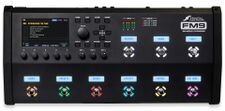
The onboard footswitches on the FM3 and FM9 – each with variable-color LED ring and mini LCD display — provide both tap and hold functions, which can be customized to do stuff, using switch layouts and views, globally or pre-preset.
Programmed is explained in depth in the Owners Manuals and in the Footswitch Functions Guide. Read this: FC-6 and FC-12 foot controllers.
FC controllers and FASLINK
The Axe-Fx III, FM3 and FM9 can be expanded with up FC controllers. The FM3 and FM9 support two FCs, and the Axe-Fx III supports four FCs, through FASLINK connections.
Read this:
Powering on
The Axe-Fx III displays system startup messages when powering on.
You can make the FM9 do the same by pressing-and-holding ENTER while the unit powers up.
User interface
Navigate and operate
- VALUE wheel, with push-button function (which can be disabled in the Global Settings menu).
- NAV buttons. On the Home page these let you switch presets (left/right) and scenes (up/down).
- PAGE LEFT/RIGHT buttons.
- HOME menu button.
- EDIT button.
- ENTER/EXIT buttons. ENTER also jumps to the layout grid from any screen.
- 5 rotary push-buttons (ABCDE) perform various functions in the GUI.
- Output level knobs for the 4 outputs.
Shortcuts
- Double-tapping EDIT edits the previous block.
- Double-tapping HOME enters the layout grid.
- Double-tapping STORE prompts immediately.
- When on the Home or Layout pages, double-tapping the Quick Entry knobs does the following:
- A: Enters the Amp 1 menu (A = Amp)
- B: Enters the Drive 1 menu (B = Boost/Drive)
- C: Enters the Cab 1 menu (C = Cab)
- D: Enters the Delay 1 menu (D = Delay)
- E: Enters the Reverb 1 menu (E = rEverb)
Performance Pages:
The Performance Pages allow fast access to max 10 often-used parameters per page. You can choose these in the editor on the Perform screen. You can use block parameters, parameters from controllers (including Tempo), global parameters. There are Global Perform and Per-Preset Perform pages. Soft-knobs D resp. E let you jump to the Edit menu of AMP 1 resp. AMP 2.
VALUE wheel
- (Axe-Fx only) Press this to switch to the layout grid (unless disabled in the Global Settings menu). Press HOME or another button (not EXIT) to leave the layout screen..
HOME page
- Press ENTER to jump to the layout grid. Press EXIT to return to the Home screen.
- Use NAV UP/DOWN to switch scenes.
- Turn knob "A" to switch scenes.
- Use NAV LEFT/RIGHT to switch presets.
- Press Page to Global Perform or Per-Preset Perform and push the soft-knobs D resp. E to jump to the Edit menu of AMP 1 resp. AMP 2.
- Press Edit to open the Edit menu of the currently selected block (not visible).
- Turn knob "B" to switch to the large display mode (FM3 and FM9 only).
AMP block > Output EQ
- Press ENTER to flatten all bands, and NAV UP/DOWN to change bands.
- Press NAV UP/DOPWN to change the EQ type.
CAB block
- Go to Cab Number field and press ENTER to view the Cab Picker.
LAYOUT GRID:
- Press-and-hold ENTER to create (or clear) a series of shunts.
- Page to the TOOLS menu, and use the Value wheel or soft-knob A to select a function: move or copy rows/columns, copy a channel, copy a scene, manage Global blocks (Axe-Fx only).
- Press ZOOM to view the preset's VU meters (reference for setting preset levels).
Block Edit menu:
- Press EDIT again to advance to the next block in the preset (top-to-bottom, left-to-right).
GENERAL:
- Press EDIT after storing a preset to go right back to where you were.
- If you navigate anywhere from the Home page, EXIT will return you to the first screen of that page.
CONTROLLERS:
- Press TEMPO to open the Controllers menu.
SEQUENCER:
- Press ENTER to randomize.
Preset slots
Number of preset slots:
- Axe-Fx III Mark I: 512
- Axe-Fx III Mark II and TURBO: 1024 presets
- FM 3 and FM9: 512
(Axe-Fx III Mark I) "The hardware is not capable of supporting more presets." [99]
(Axe-Fx III Mark I) "If you want more preset space you would have to sacrifice user IR space. Each preset uses the equivalent of two user IRs. There are three FLASH chips on the DSP module: one for presets, one for factory IRs and one for user IRs." [100]
Read this:
Effects list
Click on the image below:
Firmware 20 for the Axe-Fx III added the Dynamic Distortion block to the Axe-Fx III.
There's a comparison between the various hardware products in the Blocks Guide.
- The FM3 has no Vocoder, no Tone Match, no IR Capture, no Real-Time Analyzer, no IR Player, no Crossover, no Dynamic Distortion.
- The FM9 has no Vocoder, no Tone Match, no IR Capture, no Real-Time Analyzer, no IR Player, no Dynamic Distortion.
- There are less instances of certain blocks on the FM3 and FM9.
- Effect blocks on the FM3, FM9 and Axe-Fx III have the same number of Channels. Except for the Multiplexer (less channels on the FM3).
- The two Delay blocks on the FM3 do not have diffusion parameters.
- Reverb on the FM3 defaults to a lower quality mode.
- The FM3 and FM9 provides less looping time in the Looper block than the Axe-Fx III.
- The FM3 and FM9 may not have the most recent Pitch algorithm (at the time of writing) because of CPU constraints.
- The FM3 and FM9 do not support "dual source" modifiers.
- Maximum delay time is 16 sec for the Axe-Fx III and FM9, and 8 sec for the FM3.
- Reverbs require a lot of CPU on the FM3, much less on the FM9 (they have their own DSP core).
- The FM3 doesn't provide multiple types in the Megatap Delay block.
- Only the Axe-Fx supports Global blocks.
- Amp modeling: the FM3 has a single Amp block, where the Axe-Fx III and FM9 have two amp blocks per preset. Some Amp block features are not available on the FM3, such as Bias Tremolo and Input Dynamics.
- Cab modeling: the FM3 provides a single Cab block with two IRs, the FM9 has two Cab blocks with two IRs, and the Axe-Fx III has two Cab blocks with four IRs each. The FM3 and FM9 provide 1024 user cab slots vs 2048 on the III. A limited number of Cab block features is not available on the FM3: Smoothing. On the FM3 and FM9, cab modeling runs in a FIR accelerator. This FIR accelerator offloads processing from the CPU and, as such, doesn't reflect in CPU usage. The accelerator supports IRs up to 1K. FullRes IRs are supported only on the Axe-Fx models.
(FM3) "Due to the lesser processing power there are fewer instances of many effects, i.e. two instead of four. Channel counts are the same."
(FM3) "Only one amp block. (...) It does not have all of the Axe-Fx III effects but has the most important ones (no vocoder, etc.)."
(FM3) "We could potentially do two amp blocks but at reduced quality and I don't want to do that. Part of the problem with other modelers is that they don't oversample enough (and use single-precision in places where you need double-precision). Then you get complaints of artifacts and ear fatigue and all the other things associated with inadequate sample rate and word length. The vast majority of users only use one amp block so we wanted to make something with one very high quality "Ares" amp block."
(FM3: Cab block runs on CPU accelerator) "It's a CPU accelerator thing. A second Cab block would use a lot more than 3%."
(comparing the FM3's amp modeling to the Axe-Fx III) "They are the same quality. Certain features were removed to allow the algorithms to run including the bias tremolo, input dynamics processing, and several other inauthentic enhancements." [101]
(FM3) "We removed all the superfluous stuff (bias tremolo, dynamic presence/depth, etc.) in order to get the core amp modeling to run on the slower processor." [102]
(FM3) "The Axe-Fx III contains various algorithms that allow you to enhance the amp modeling that don't exist on a real amp. I.e. dynamic presence/depth, input dynamic processing, etc. These were removed to allow the core amp modeling to run on the lower-powered processor." [103]
(FM3) "The changes to the Megatap block have not been ported to the FM3 at this time. They may or may not be ported at some future date." [104]
(FM3) "The Axe-Fx III contains various algorithms that allow you to enhance the amp modeling that don't exist on a real amp. I.e. dynamic presence/depth, input dynamic processing, etc. These were removed to allow the core amp modeling to run on the lower-powered processor." [105]
”FM3/9 only support 1K samples for normal IRs since the IR processing is handled by a coprocessor whose max. length is 1K samples.” [106]
